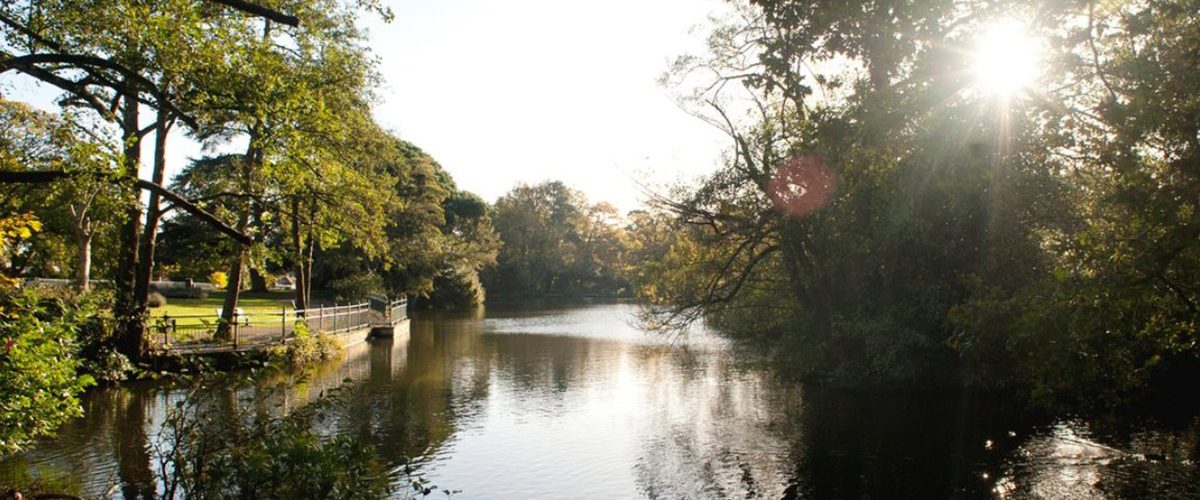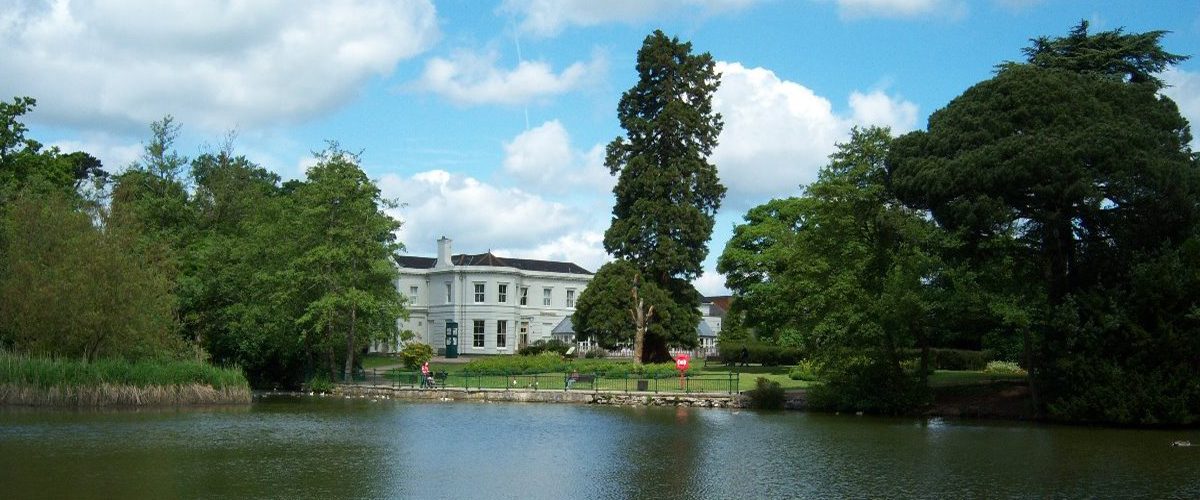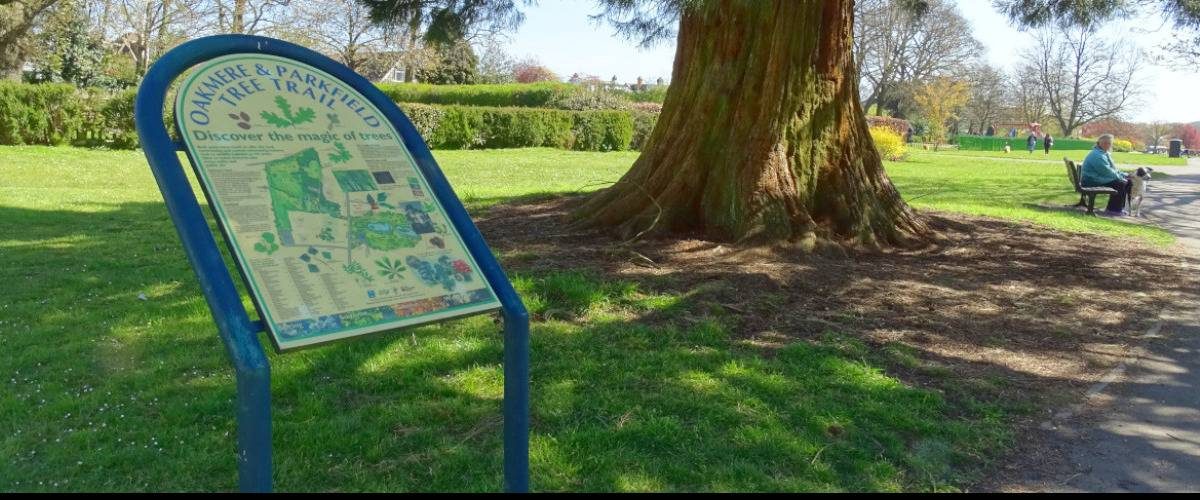Oakmere Park
Open all year. Toilets are open April to October 7am-9pm, November to March 7am-4pm
Potters Bar main park. 6.2ha with 4 routes and 3 Points of Interest
Alder T4
Feature Tree
Origin: Native
This is a water-loving tree and grows along stream and riverbanks creating shade for plants and fish. This tree is quite a small tree, growing to 21 metres and can live for 150 years. The Alder produces small female cones which last throughout the winter and has a display of dark yellow male catkins in March. The wood is still used to this day for whistles and pipes – musicians often played in the Alder’s top branches. The leaf buds are used in colour dying as they produce purple. Charcoal from this tree was traditionally used in the making of gunpowder and coppices of alder were planted near gun power works.
Atlas Cedar T3
Feature Tree
Origin: Algeria and Morocco.
This Cedar has ascending branches of attractive blue foliage with needle-like leaves. Was introduced as an ornament in parks and gardens in Europe and North America. Has attractive barrel-shaped cones which take 2-3 years to develop.
Common Lime T12
Feature Tree
Origin: Introduced
This tree provides colour all year round – fragrant clusters of yellow flowers open in July and the heart shaped leaves are bright green. In winter, attractive, vibrant red buds appear ready to start the life cycle all over again. A distinctive feature of the lime is the ‘suckers’ produced at the base of the trunk.
Copper Beech T30
Feature Tree
Origin: Europe
Young beech trees keep their leaves in winter putting on a russet display, which you can often see in hedging. The beech has shallow roots but it can grow to a magnificent height of over 30 metres.
The name come from the Greek work ‘fagein’ meaning ‘eat’ as the nuts were used in pig fodder. The copper beech has dark purple leaves which fade to green with a purple tinge before turning copper in autumn. The Beech can be identified by its sharp long leaf buds in winter.
Corsican Pine T27
Feature Tree
Origin: Corsica, Southern Italy & Sicily
Now one of Britain’s most important forestry trees due to its strong timber. It grows to 45 metres, with a slender narrow shape.
It produces egg-shaped yellow brown cones. The bark is nearly black and scaly. This Pine is often planted as a shelterbelt to protect areas from strong winds.
Deodar T28
Feature Tree
Origin: Himalayas
A quick growing conifer which can reach a height of 25 metres and is long lived. It is also known as the ‘Himalayan Cedar’. The long needles grow in a ‘spiral’ and are a grey-green colour. This cedar has drooping lower branches.
English Yew T13
Feature Tree
Origin:Native
The Yew is the oldest living tree in Europe (the Fortingall Yew in Scotland is believed to be 3-5000 years old). It has sacred origins from the Druids and Celtic times and is often found in churchyards as churches were often established on sacred sites.
The Yew can reach 20m in height. The evergreen leaves were once used as ‘palms’ for Palm Sunday. The smooth bark is purple/brown and peels as the tree ages. Both the leaves and bright red seeds are poisonous.
Field Maple T7
Feature Tree
Origin: Native
This small tree has lobed leaves which give a colourful display. When the leaves are young they are bright red, as they mature they turn green. In the autumn they turn yellow and red. The winged fruits produced in autumn provide food for small animals.
The field maple is grown in hedgerows and makes an excellent nesting site for birds. These 10 trees were planted to celebrate the 10th anniversary of Potters Bar in Focus.
Hawthorn T11
Feature Tree
Origin: Native
Be careful – this tree has very sharp thorns! This tree can reach 10 metres and forms an attractive umbrella shape in spring. Dark red berries provide food for many of our native and winter visiting birds. It has beautiful fragrant, white flowers known as May blossom, which appear in spring. It is also known as the ‘May Tree’ due it its ancient associations with May Day festivities (used as May Pole and May Day garlands) and much superstition surrounds it – it is unlucky to bring flowers inside the home. It is also referred to as ‘Christ’s Crown of Thorns’ due to the sharp thorns.
Health Walk Start Point
Health Walk Start Point
Meet every Monday at 11am for our easiest walk, its 20 – 30 minutes long on flat and even ground at a gentle pace, no stiles with regular stopping places
To find out when you can get involved check out the Health walks website;
https://www.walkingforhealth.org.uk/walkfinder/east-england/hertsmere-health-walks
Maidenhair Tree T6
Feature Tree
Origin: China
This is the oldest tree surviving in the world today and would have been grazed by dinosaurs over 350 million years ago! The imprint of the unique fan shaped leaf has been found in fossils. The tree can live to quite an age – over 1000 years. The tree is used to the hot Asian summers and can’t survive exposed cold areas. Can grow to over 30 metres. The leaves appear in April, turning bright yellow in October before falling in November. Kew Gardens contains a specimen which is over 230 years old.
Play Area
Toddler Play Area
Fenced play for children up to the age of 8 with the following equipment;-
- Toddler Multi-Play / Platform Slide
- 4 Cradle swings (Toddler)
- 2 Flat swings
- Balance Beams, Wobble log & Rubber Stepping Stones
- Tunnel
- Talk tube
- Toucan Springer
- Duck Springer
- Gondola Rocker
- Play Car
- Roundabout
- Multi-Play
Scots Pine T5
Feature Tree
Origin: Native (Scotland)
This evergreen conifer can grow up to 35 metres tall. The Scots Pine could be found in the wild forests in Scotland over 2000 years ago – travellers had to risk passing through the wilderness where highwaymen and wolves lurked. The wood was used in roofs and ships and is used this day in forestry. The egg-shaped cones can be used as kindling and the bark resin as antiseptic oil. It has attractive red flaky bark.
Snakebark Maple T10
Feature Tree
Origin: China
As the tree ages, it develops a beautiful smooth ‘snakeskin’ bark with olive green and white stripes. It is quite a small tree, growing to a height of 15 metres and is used as a specimen in parks and gardens. It has small green flowers in spring followed by winged fruit. The tree puts on a colourful autumn display. These are quite young examples and were planted in approximately 1999.
Sweet Chestnut T29
Feature Tree
Origin: Southern Europe
The Sweet Chestnut was probably introduced by the Romans to bring us a harvest of nuts which can be roasted or ground for flour. It can grow to over 30 metres and is long lived. Cord-like catkins appear at the end of June. The leaves turn bright yellow in Autumn. The chestnuts develop in 1-3s in yellow hairy cases and fall to the ground in the autumn. Can you see how the bark twists and cracks?
Sycamore T2
Feature Tree
Introduced in 15-16th Century, the Sycamore scatters yellow winged fruit in autumn, called ‘helicopters’, which can quickly set seed. It is said that the Tolpuddle Martyrs formed the first trade union underneath a sycamore tree – which is the oldest sycamore tree in Britain dating over 250 years. This tree can reach a height of 30 metres. The palmate leaves are dark and leathery and it produces clusters of yellow flowers in April. The wood has numerous uses – from violins to wooden spoons. The Sycamore is resistant to pollution.
Wellingtonia T1
Site of historical interest
This evergreen coniter is also referred to as the “Californian Big Tree” and, as the name suggests, can grow to quite a height in its native home (over 110 metres) and can live for over 3,000 years. Here in the UK it can reach 45 metres. It has a “Spire” like form. The cones can take up to 2 years to mature. The scale – like leaves have a strong aniseed smell when crushed. The bark is pinkish- brown and develops ridges as it ages.
Wild Cherry T8
Feature Tree
Origin: Native
This is a beautiful native woodland tree and can grow up to 30 metres. It has shiny red-brown bark which peels. Delicate white blossom appears in April-May just before leaves. Bitter fruits (cherries) turn from yellow to dark- red as they ripen and are popular with birds, mice and squirrels. You will often find cherry stones around the base of the tree in late summer. The leaves turn fiery colours of yellow and crimson in autumn. The wood is used in musical instruments and crafts.
Wildlife Tree T9
Feature Tree
Dead wood is important for wildlife and where it is safe so to do it is retained. Standing dead trees and high branched are important for woodpeckers, bats, beetles and fungi – dead wood lying on the ground will provide a home for different species. The now rare Stag Beetle is particularly reliant upon standing dead wood. Can you see any beetles?
Park Information
Oakmere Park was once the grounds to Oakmere House which is now operated as a restaurant and public house and provides a welcoming retreat with pleasing views across the park.
The classic 19th century layout of the park with lakes and specimen trees is still largely intact, although the grand entrance lodges and sweeping carriage way have been removed.
The park has a lot of history attached to it. On the night of 1 October 1916, a ‘Super Zeppelin’ was shot down over the park by Second-Lieutenant WJ Tempest. The road that borders the park was named Tempest Avenue in his honour. The Zeppelin crashed onto an oak tree to the east of the park the pilot and all his crew were killed.
Events are a major feature of the park.
On Site Facilities
- Car Park (Free)

- Car Park (Pay & Display)

- Disabled Access

- Disabled Toilets

- Dog Free Area

- Dogs Welcome

- Food & Drink

- Pushchair Friendly Paths

- Toilets

Park Routes
View more routes View all routes on map
How to get here
Parking:Pay and Display car park of Salisbury Close. Directions here
Public Transport Information:
Buses PB1,84, 242, 302, 312, 398, 610, 611 & 841 all stop on the High Street
Potters Bar station is approximately 15 minute walk away.
For more information on public transport visit www.intalink.org.uk/timetables or www.nationalrail.co.uk
Cycling:No cycle parking facilities available.








Share your experience
Tell your friends on social media about what you did at Oakmere Park: